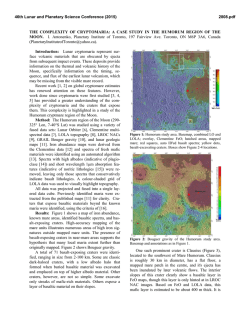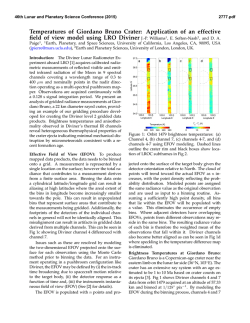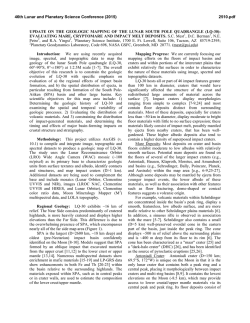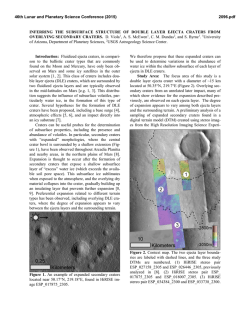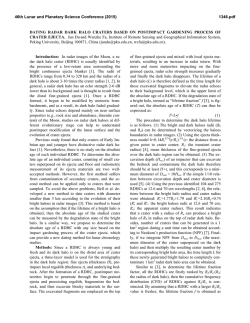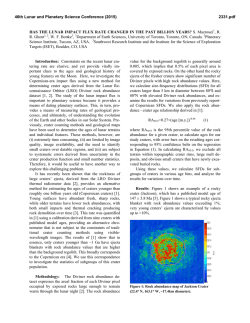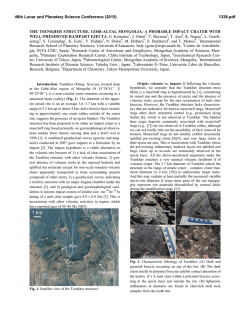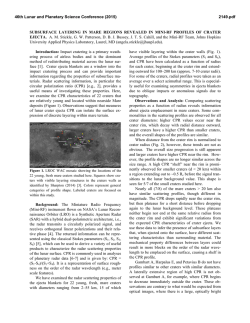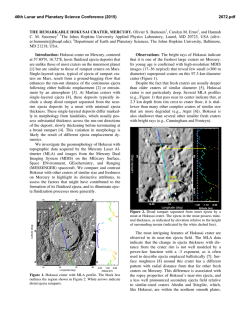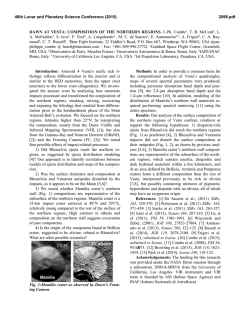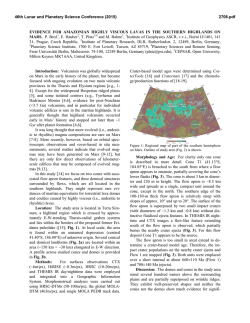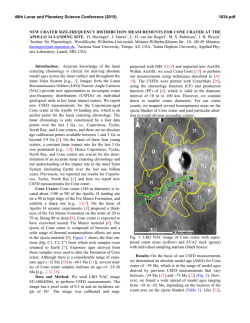
PHYSICAL PROPERTIES REVEALED BY RADAR AND THERMAL IN
46th Lunar and Planetary Science Conference (2015) 1979.pdf LUNAR CRATER EJECTA: PHYSICAL PROPERTIES REVEALED BY RADAR AND THERMAL INFRARED OBSERVATIONS. R. R. Ghent1,2, L. M. Carter3, and J. L. Bandfield4, 1Dept of Earth Sciences, University of Toronto, 22 Russell St., Toronto, ON, Canada, [email protected], 2Planetary Science Institute, Tucson, AZ, USA, 3NASA Goddard Space Flight Center, Greenbelt, MD, USA, 2Space Science Institute, Boulder, CO, USA. Results: Previous work has shown that it is possible to quantify the relationship between surface ejecta rock content and crater age for craters younger than ~1 Gyr [4] (Figs. 1, 2); and, moreover, that craters older than ~1 Gyr show low ejecta RA values that are indistinguishable from the background regolith. Many old craters (up to 3500 Ma), however, show elevated radar CPR values in their ejecta, indicating that a) these ejecta blocks are buried under at least a few tens of cm of regolith; and b) buried ejecta blocks can persist for much longer than is typical for surface rocks. 10-1 RA95/5 = 0.27 age(m.y.)-0.46 R2 = 0.96 GB MF BA RA95/5 Introduction: The lunar regolith is derived from impact ejecta, and so understanding ejecta characteristics is a key element of regolith studies. Here we report on the physical properties of impact ejecta from Earthbased and orbital radar (Arecibo / Green Bank telescopes at 12.6- and 70-cm wavelengths, and the Lunar Reconnaissance Orbiter Mini-RF) and LRO Diviner thermal infrared observations. Radar and thermal infrared (IR) observations are highly complementary. Nighttime multispectral thermal IR observations provide estimates of surface rock abundance [1], which is calculated by taking advantage of the fact that large rocks, with their high thermal inertia, stay warm through the lunar night, whereas finegrained regolith, with low thermal inertia, cools relatively rapidly after lunar sunset. Pixels containing a mixture of large rocks and regolith give rise to integrated radiance values interpreted to indicate differing brightness temperatures by each of Diviner’s three thermal IR channels; this “anisothermality” allows calculation of the fraction of each pixel covered by exposed large rocks (the rock abundance, or RA, reported for each pixel as a number between 0 and 1), and the temperature of the fine regolith fraction. Because the lunar regolith is highly insulating [2], only rocks not covered by regolith are identified in the Diviner RA dataset. Therefore, we can reliably identify surface rocks, and distinguish them from buried rocks. Radar datasets, by contrast, reveal shallowly buried rocks, covered by regolith up to several meters deep, depending on the radar wavelength. In particular, we use radar circular polarization ratio, CPR, as a proxy for blockiness. Here, we use Earth-based radar observations from the Arecibo and Green Bank telescopes at 70- and 12.6-cm wavelengths [e.g., 3], and the LRO mini-RF dataset at 12.6 cm. These four datasets (three radar and the Diviner RA datasets) represent a spectrum of observational wavelengths, and their intercomparison provides a means of constraining both ejecta block content and depth extent. We examine all craters on the lunar nearside that show evidence for blocky ejecta, whether buried or on the surface, in order to investigate spatial, crater size-, and time-dependent variations in ejecta block size distribution and spatial extent. We also investigate the properties of fine ejecta that give rise to radar-dark haloes, using new information from Diviner. N T A J 10-2 South Ray 6.8-17.5 Ma C K North Ray 45.9-79.8 Ma 100 101 102 Model age (Ma) 103 Figure 1; from [4]. Plot of 95th percentile Diviner RA value (RA95/5) vs. model age for nine index craters with published ages. See [4], Tables 1 and 2 for crater characteristics and ages. Blocky crater ejecta. For craters with high radar CPR (blocky) ejecta blankets, we find no apparent relationship between peak or mean radar CPR value and crater age. A weak correlation exists between CPR value and crater radius, but normalizing CPR value by crater size still does not produce a correlation with crater age. This result holds for both mare and highland terrains. Therefore, ejecta blocks buried beneath even a small depth of regolith (a few cm to tens of cm is sufficient to obscure rocks from detection by Diviner) can survive largely unaltered by the constant 46th Lunar and Planetary Science Conference (2015) bombardment responsible for breaking down surface rocks. 0.05 a) Giordano Bruno b) Aristarchus 1979.pdf quantify rock burial depths and fine-grained halo thicknesses, so that we can place a quantitative constraint on this process. c) Copernicus Background regolith LRO Mini-RF total power 0 10 km 1.0 AO-GBT 70cm CPR Diviner RA AO-GBT 70-cm CPR mosaic (0-1) Ejecta 50 km 0 Diviner rock abundance (0-5%) Figure 2. Diviner RA maps (top) and radar observations (bottom) for Giordano Bruno, Aristarchus, and Copernicus craters, showing decreasing surface rock abundance with increasing crater age. Fine-grained ejecta. A second ejecta facies exists distal to the blocky continuous ejecta for large numbers of lunar craters. It is characterized by low radar return and low radar CPR values [5-8]. [7] interpreted these radar-dark haloes to be depleted in radar-wavelength scale rocks. Now, we can analyze these features using Diviner observations (Fig. 3). We find a notable lack of large surface rocks associated with these radar-dark haloes, supporting their intpretation as a block-poor facies. Like the blocky ejecta, we find that these features retain their low radar CPR and low Diviner RA characteristics to ages in excess of 3 Gyr. Interpretations and ongoing work: We have previously observed [4] that most lunar craters have lost their surface ejecta rocks; but the persistence of high radar CPR values to old crater ages indicates that buried ejecta persist for long periods. Furthermore, rockfree, fine-grained ejecta haloes also persist. Both these observations place an important constraint on the nature of action of small impactors responsible for breaking down surface rocks. Shallowly buried ejecta blocks are sheltered from these small impactors, and seem to have remained so for up to 3.5 Gyr. Similarly, rockpoor haloes have remained rock-free, indicating that no efficient mechanism exists for repopulating the upper regolith with blocks. Both observations point to a relatively quiescent state of the upper regolith (from the perspective of large rocks) over the past ~3.5 Gyr. Using further comparative analysis of the four datasets at our disposal, we are currently working to further Aristarchus Figure 3. 70-cm radar CPR (top) and Diviner RA (bottom) maps of Western Mare Procellarum on the lunar nearside. Arrows denote radar-dark (finegrained) ejecta haloes. References: [1] Bandfield J. L. et al. (2011) JGR, 116, E00H02, doi:10.1029/2011JE003866. [2] Hayne P. O. et al. (2011) AGU Fall Mtg Abstracts, vol. 1, p. 1712. [3] Campbell B. A. et al. (2007) IEEE Trans. Geosci. Remote Sensing, 45 (12), 4032–4042. [4] Ghent R. R. et al. (2014) Geology 42 (12), 1059-1062. [5] Thompson T. W. et al. (1970) Radio Sci., 5(2), 253– 262. [6] Thompson T. W. (1974) Moon, 10, 51–85. [7] Ghent R. R. et al. (2005) JGR 110, E02005, doi:10.1029/2004JE002366. [8] Ghent R. R. et al. (2010) Icarus 209, 818-835.
© Copyright 2026
